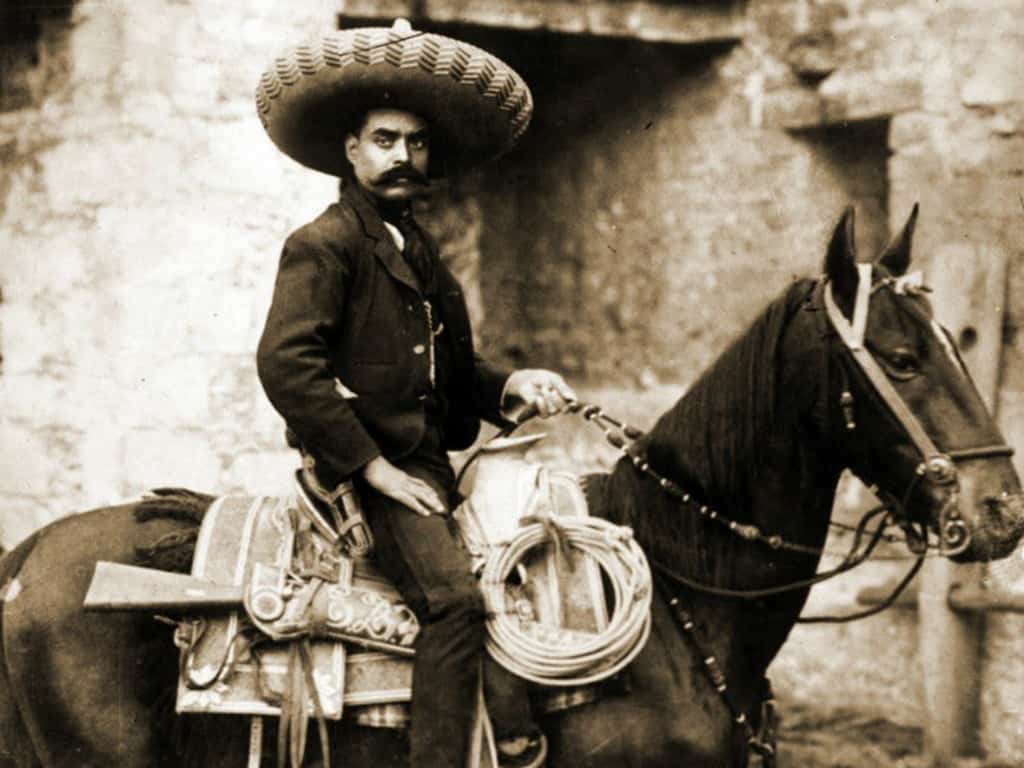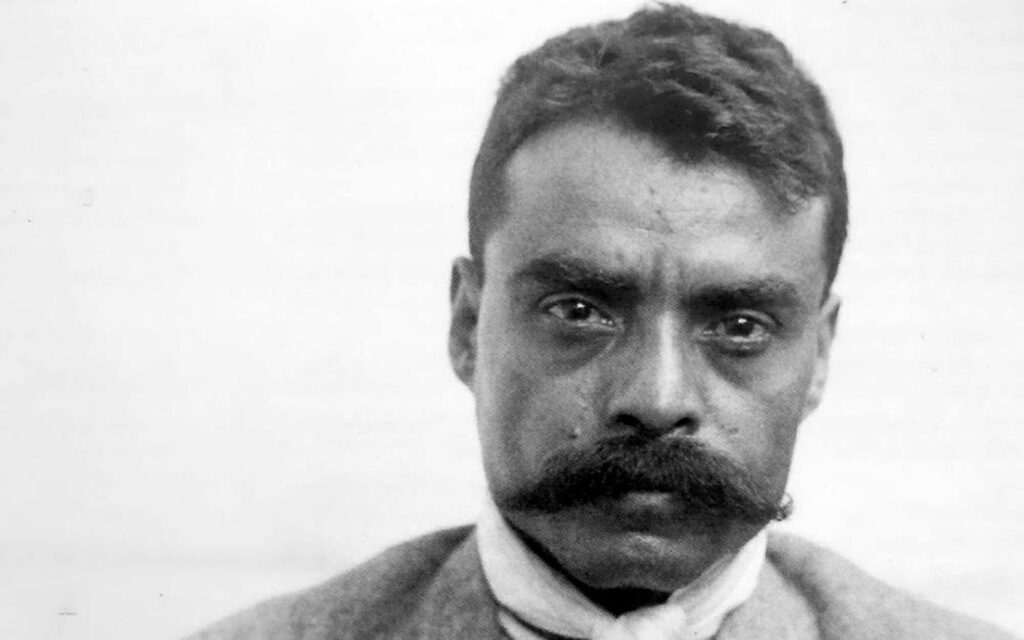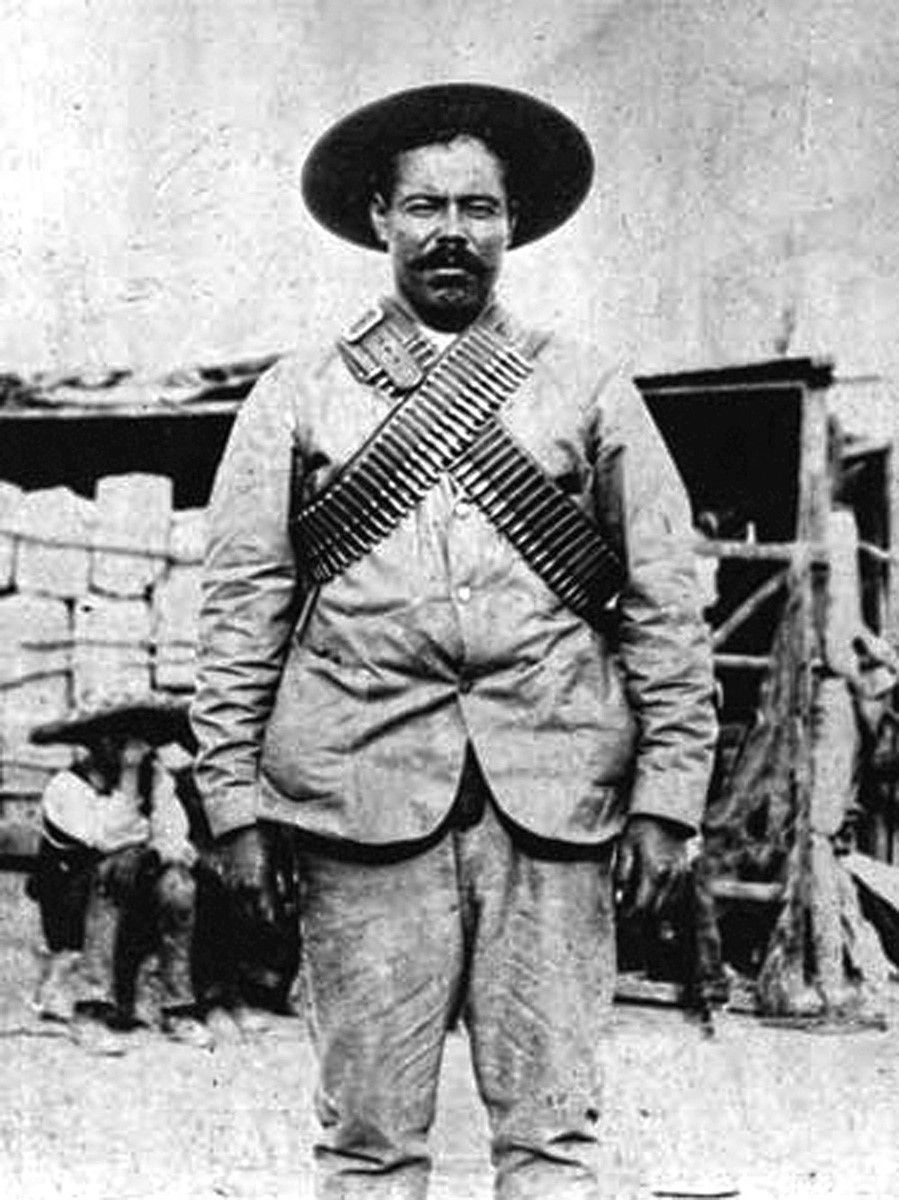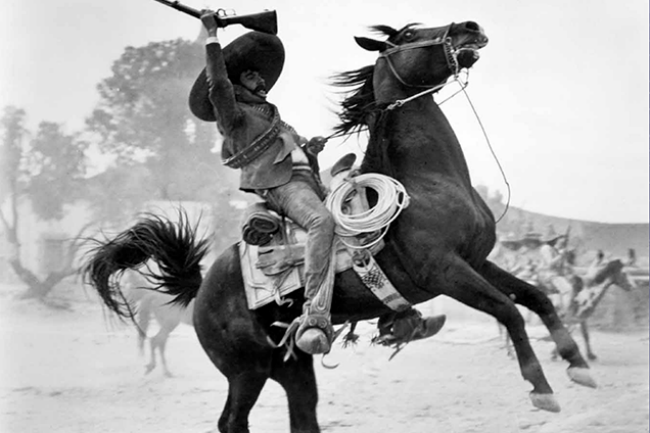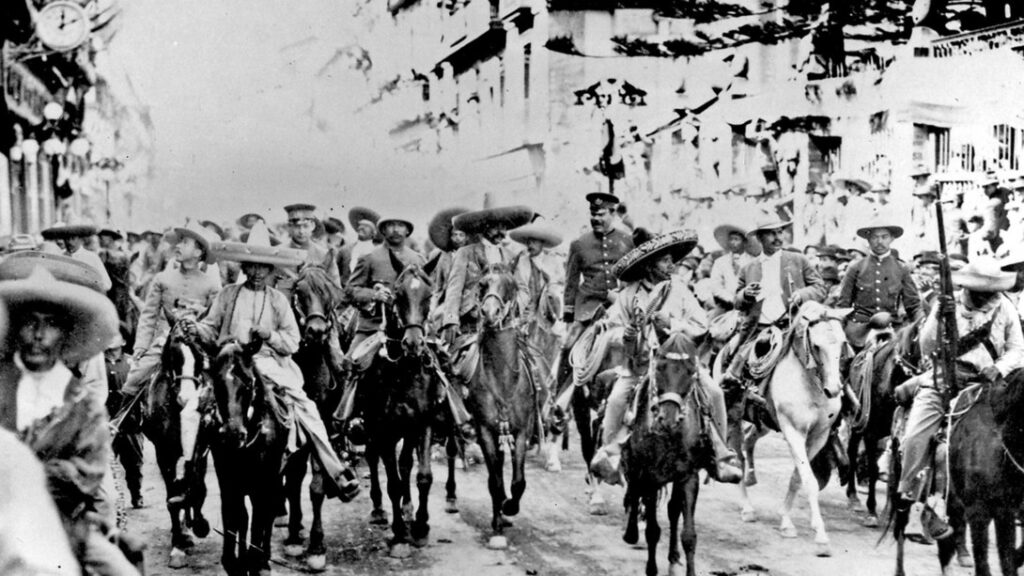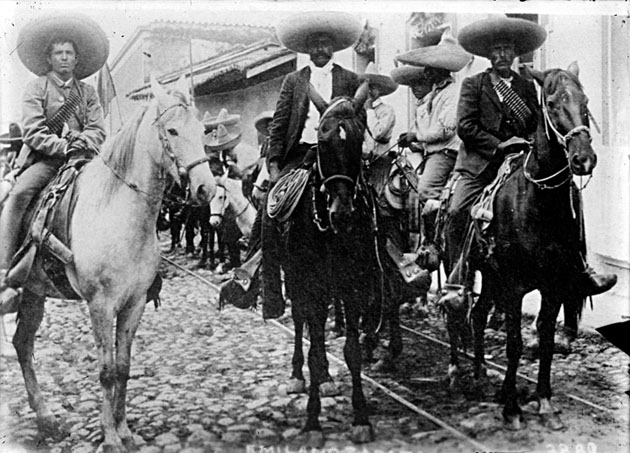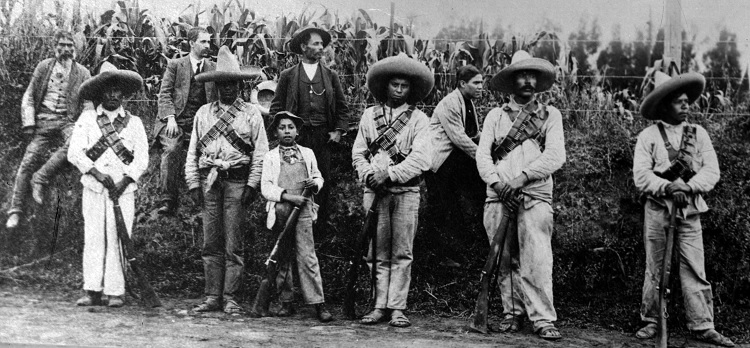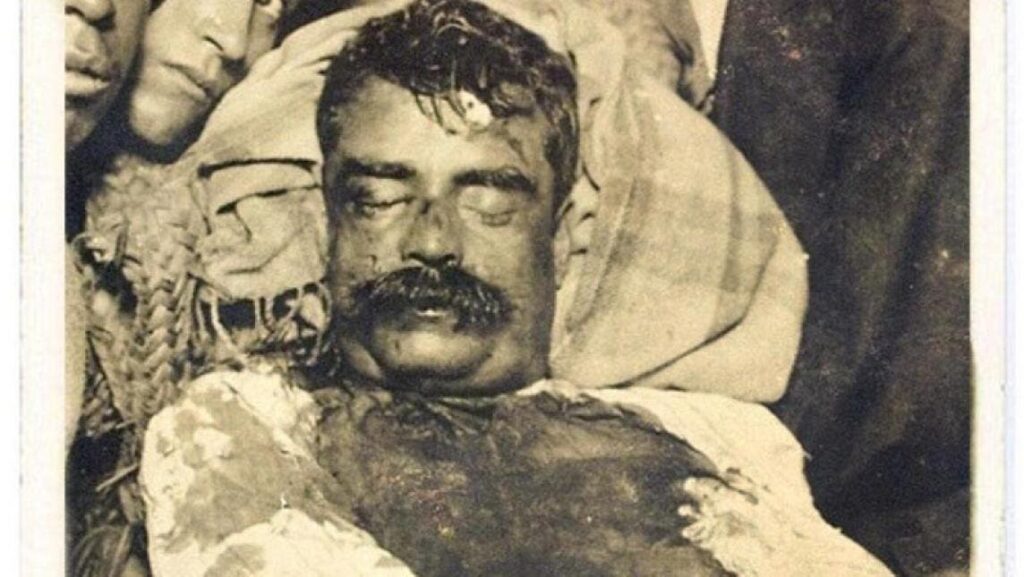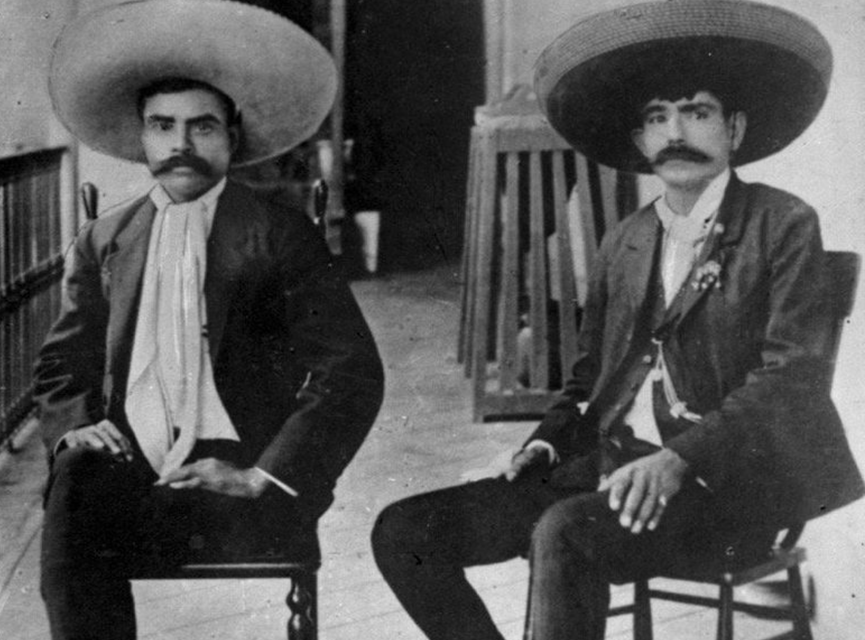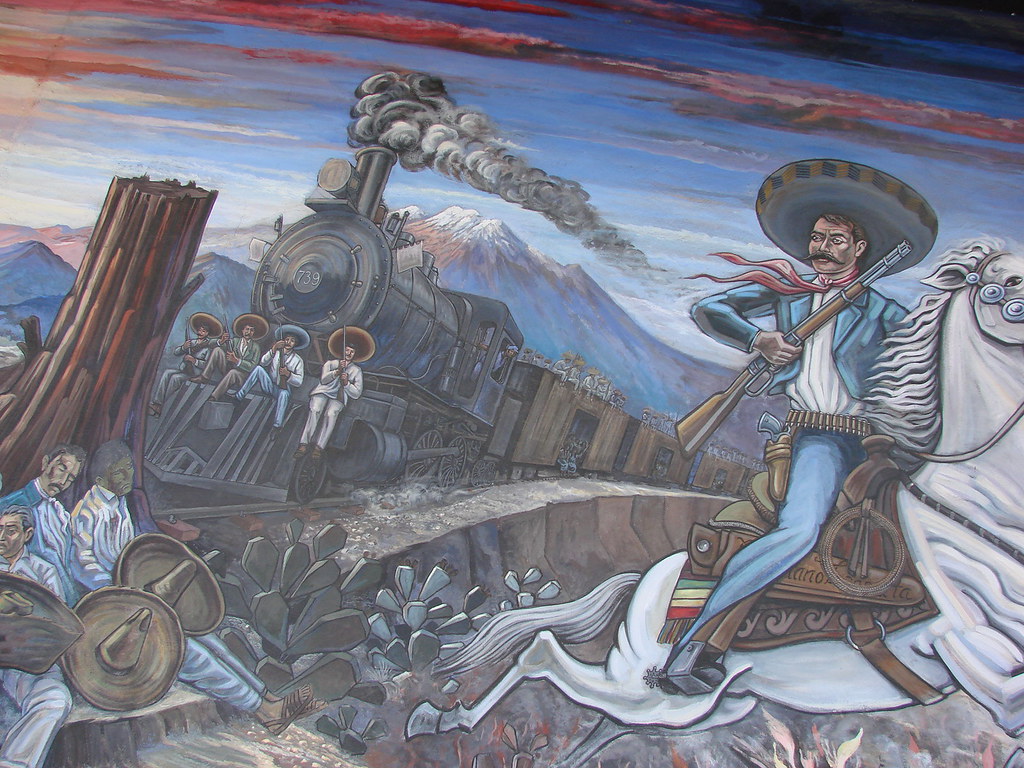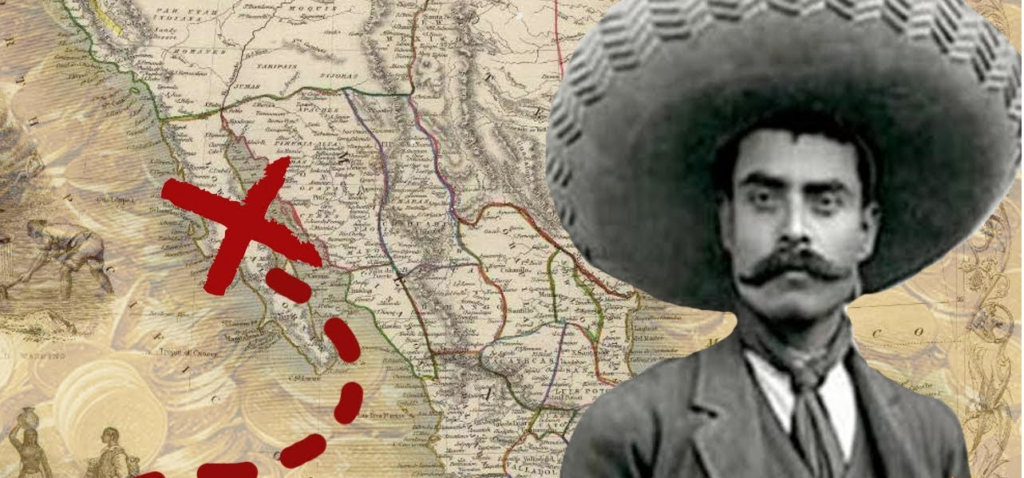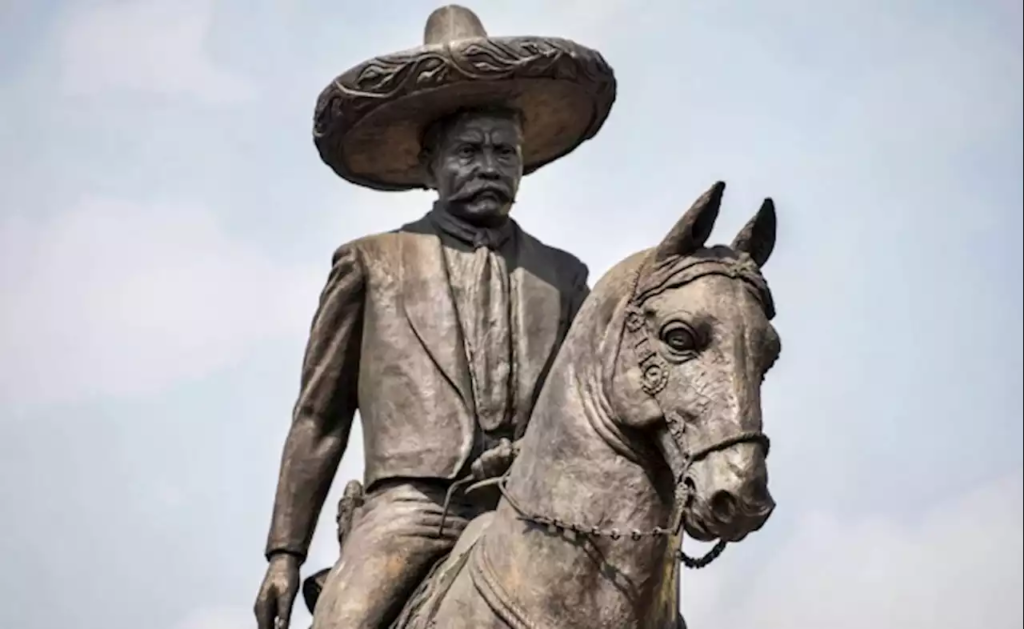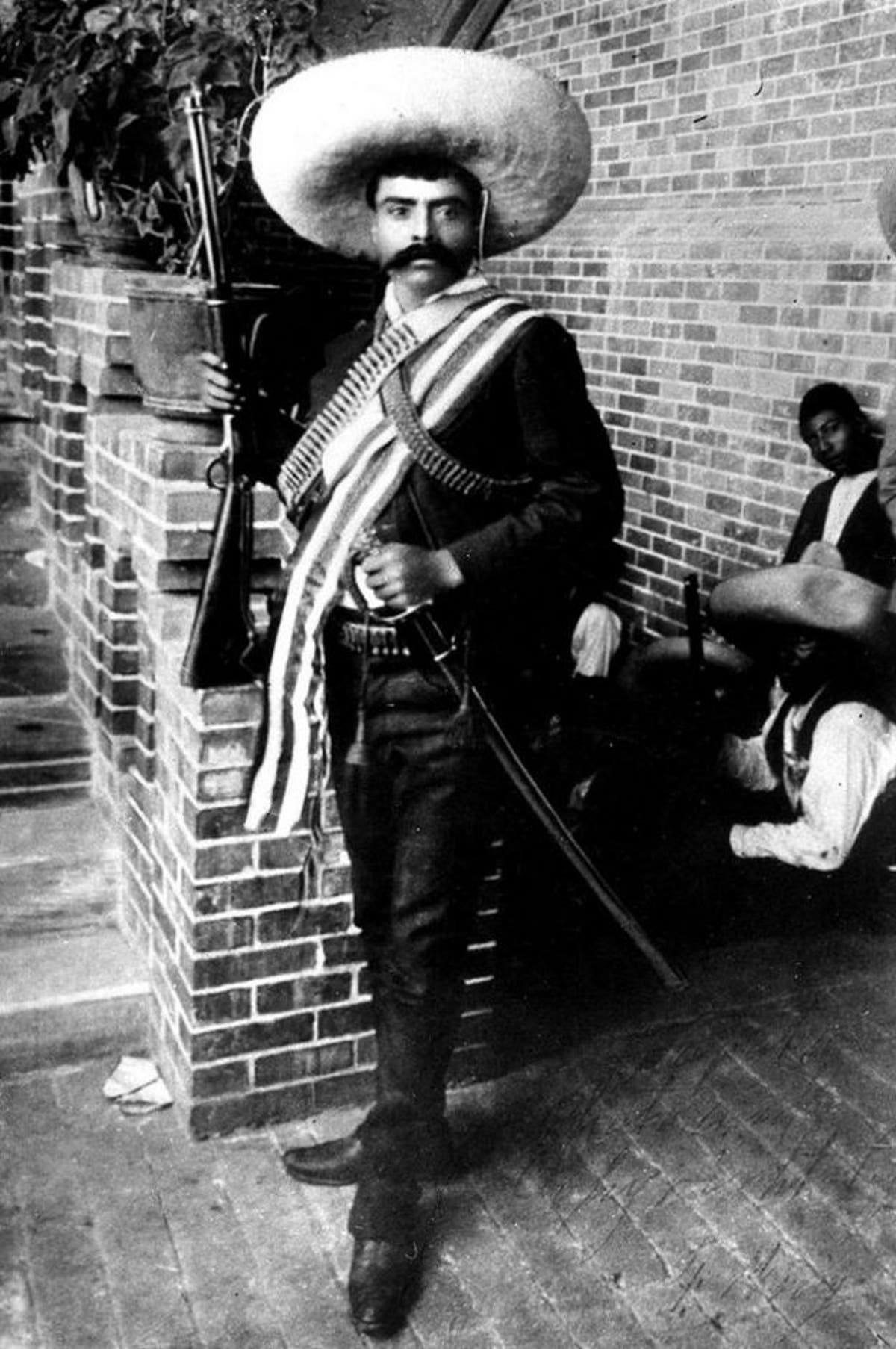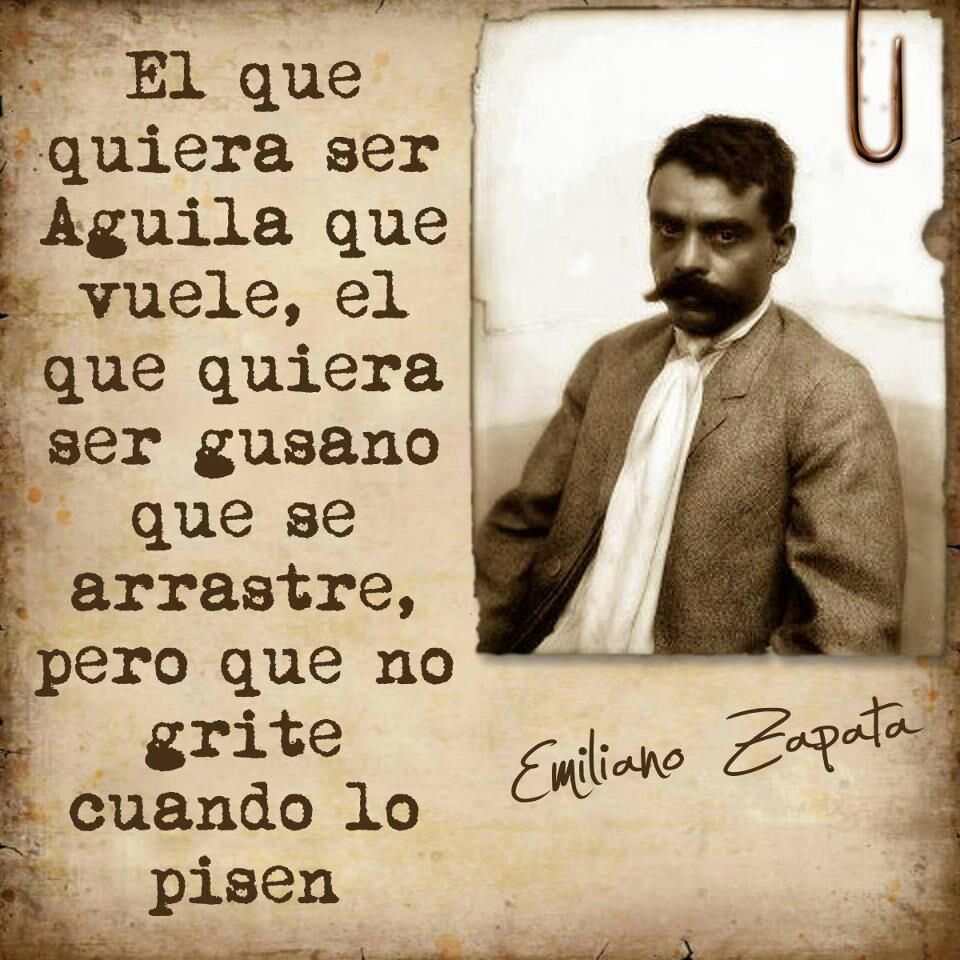Emiliano Zapata, a revolutionary man from Mexico, who since his youth and as a result of acts suffered by his family, due to the violent seizure of their lands, and of many of the peasant settlers, promised that the lands would be returned to whoever belonged to them. Learn interesting history.

Emiliano Zapata: Biography
Emiliano Zapata Salazar, was born in San Miguel Anenecuilco, town of Ayala, Morelos, Mexico, on August 8, 1879. He was known as Emiliano Zapata, being one of the main military leaders and most significant local that the Mexican Revolution had. , as well as an icon that marked the agrarian integrity in the Aztec country.
Being a member of the revolutionary movement, he remained active in charge of the Liberation Army of the South. Likewise, he was known under the pseudonym of the "Caudillo del Sur". He was an idealist and promoter of fighting for social welfare and agrarian channels.
He also fought for social justice, freedom, parity and social democracy, land ownership, consideration and respect for the indigenous populations, peasants and works of Mexico for being victims of the oligarchic system and the latifundismo of the owners of Porfiriato estates.
However, it must be kept in mind that Emiliano Zapata was also discarded along with Pancho Villa, from the Constituent Congress of 1917, to whom the emergence of social constitutionalism is due, which can be evidenced in article 27.
The Beginning
Emiliano Zapata, was born into a peasant family, son of Gabriel Zapata and Cleofas Salazar, had the company of six sisters who were named Celsa, Ramona, María de Jesús, María de la Luz, Jovita and Matilde, and with three brothers by names: Pedro, Eufemio and Loreto.
José Salazar, his maternal grandfather, also exercised the military profession under the orders of José María Morelos y Pavón, in the city of Cuautla de Morelos. Likewise, his paternal uncles named Cristino and José Zaparon fought in the Reform War and during the French Intervention under the command of Generals Carlos Pacheco and Porfirio Díaz.
His childhood was developed in an environment of Porfirista latifundism in Morelos. The first steps of her studies were carried out with the teacher Emilio Vara, who was previously a Juarista soldier.
While his parents were alive, Emiliano lived through the event that marked his destiny: the owner of the neighboring Cuahuixtla hacienda had seized his Anenecuilco land by force. While many peasants resisted.
Because of this fact, Emiliano witnessed how his father cried bitterly for the looting of his lands, which made him -who would later be titled the caudillo of the south-, be saddened because his father stated that he would not fight against abusers who were powerful .
At that moment Zapata was only 9 years old, he had the unpleasant experience of observing how the peasants looted his own lands, acts promoted by the owners of the nearby haciendas, and after witnessing the expressions of his father , who answered that he could not do anything to stop them, but the boy with radiance told him:
It can not be done? Well, when I grow up, I'll have them returned.
Zapata, at the age of 16, 11 months after his father's death, his mother dies. Immediately afterwards, he began his work in the agrarian world as a farmer and muleteer. For the date of June 15, 1897, he is arrested by the rural forces of the Cuernavaca municipality, while he was participating in a celebration in his hometown Anenecuilco.
With the intervention of his brother Eufemio, he managed to be released, but with the firearm in hand. Because of this event, the Zapatas brothers had to leave the state behind. Meanwhile, his brother Eufemio stayed for a year working at the Jaltepec farm located in Puebla.
First political occupations
In 1906, he participated in a meeting made up of peasants in Cuautla, to deal with issues related to protecting and safeguarding their territory, and the town's lands to confront nearby landowners.
His rebellious nature sanctioned him to enlistment, while in 1908, Zapata was included in the 9th Cavalry Regiment, under the military control of Colonel Alfonso Pradillo. While in the city of Cuernavaca, Zapata was appointed as caretaker of the horses of the hacienda, owned by Pablo Escandón, leader of the General Staff of Porfirio Díaz.
Later, he was taken to carry out the same activities under the orders of Ignacio de la Torre, who was the son-in-law of General Porfirio Díaz and feels an affection for his skill and wisdom about horses.
Arrived on January 24, 1609, a well-known Club called Melchor Ocampo was founded in Villa de Ayala, to support the candidacy against Patricio Leyva during the government of the state of Morelos, Zapata is among its members, appearing for the first time in the world of politics, and leaving behind the peasant environment. He is dedicated to supporting the candidate who is not in favor of the landowners, as is the case of Pablo Escandón y Barrón, owner of the San Diego Atlihuayán ranch.
On September 12 of that same year, Emiliano Zapata was designated as calpuleque, a word in Nahaualt, which translates as leader or president, to exercise the Defense Board of the territory of Anenecuilco, Villa de Ayala, Moyotepec, under this position, begins the process of investigating and analyzing whatever document was found and it was about the viceroyalty, where they attested to the property rights of the settlers over their territories.
Previously it had been denied by the Reform Laws, especially the Lerdo Law, which forced the different civil groups to sell or expropriate their lands that were not productive, being an issue at some point, supported by different indigenous chiefs such as the case of Tomás Mejía, to the conservative governments, as well as to the Second Empire of Mexico.
These implemented laws benefited many people to increase their acquisition of land illegally, claiming and requesting ownership of land that the residents did not work. Reason that induced him to become a different agrarian from Morelos, his native state.
In the month of February of the year 1910, he was included, within the Ninth Cavalry Regiment that was in Cuernavaca, with the military rank of common soldier.
In the month of May of the year 1910, applying the forces, he rescued the lands of the Hacienda del Hospital, which were guarded by the chief of police, Mr. José A. Vivanco, and who also handed them over to the peasants of the region. Because of this event, he had to flee on many occasions from government authorities, because he was designated as a bandit.
After a good time, a few months later he participated in the meeting held in Villa de Ayala, in order to deal with the related matter, which would later become the Ayala Plan. He managed to bring together all the neighboring residents of the three communities: Anenecuilco, Villa de Ayala and Moyotepec, with whom he began the process of the new distribution of the lands, demolishing the fences placed in the surroundings.
The Maderista Revolution and the Ayala Plan
Francisco I. Madero, promulgates the Plan of San Luis, which characterized the beginning of the 1910 Revolution, Emiliano Zapata reads a copy, which makes him curious with emphasis on the third article, which was stated in the plan, which indicated the offer return the land to its former owners.
Immediately, Zapata talks with Pablo Torres Burgos, an important rural teacher, and with Gabriel Tepepa, Catarino Perdomo and Margarito Martínez. They agree that Torres Burros, being the most educated of the members, obtained an interview with the leader of the Revolution, the famous Francisco I. Madero, in the city of San Antonio, Texas.
After the interview and according to what was discussed, they resolved to take up arms Pablo Torres Burgos, Emiliano Zapata, Rafael Merino, and approximately 60 peasants, among them: Catarino Perdomo, Próculo Capistrán, Manuel Rojas, Juan Sánchez, Cristóbal Gutiérrez, Julio Díaz, Zacarías and Refugio Torres, Jesús Becerra, Bibiano Cortés, Serafín Plascencia, Maurilio Mejía and Celestino Benítez. We recommend Biography of Guadalupe Victoria
Being gathered on March 26, 1911, in a Lenten festival in the city of Cuautla, they promulgated the Plan of San Luis.
Emiliano Zapata left for the south, because he was being persecuted by Aureliano Blanquet and his troop of soldiers. During this time corresponding to the span of the Zapatista movement, the battles of Chinameca, Jojutla, Jonacatepec, Tlayecac and Tlaquiltenango stand out, as well as the death of the Zapatista and legendary head of the Suriano movement, the well-known Pablo Torres Burgos, who in fact presided over the Emiliano himself.
After the death of Emiliano Zapato, he is chosen by the Revolutionary Junta of the South, on March 29, 1911, as the new revolutionary leader maderista of the south. The Zapatista requirements expressed their opinion of a definitive agrarian reform "The land belongs to those who work it", a slogan used by Teodoro Flores, who was the father of the Flores Magón brothers, which finally became an essential sign in his foolhardy battle for the events of Porfirio Diaz.
Likewise, Francisco León de la Barra is mentioned, who in his capacity as president, led many political and armed challenges to the leader of the south, including Francisco I. Madero himself.
So, Emiliano Zapata installed his own headquarters in the town of Cuautlixco, which is close to Cuautla. From there, he directs his attack on the Porfirista Army, protected by the 5th Regiment, under the orders of Colonel Eutiquio Munguía, just like a Rural Corps, it is under the control of Commander Gil Villegas.
On March 29, Emiliano Zapato held the position of leader of the revolutionary forces, which at that time was made up of approximately one thousand men. Arrived on April 2, they seize Huehuetlán, Puebla and manage to take the entire city by the date of May 13, 1911.
Due to the victory of the Maderismo, Emiliano Zapata was unable to dispatch troops, without each of the members being given the security of land to dedicate themselves to cultivation, instead of weapons. According to him, the battle does not end with the overthrow of Porfirismo, but with the definitive settlement of the peasant settlers: the restitution of the lands that had been stolen by the wealthy landowners.
This event was propitious for Francisco de León de la Barra, who acted as interim president, to consider it an act of rebellion, a reason that made him send forces to dominate it: a thousand men commanded by him, generals Victoriano Huerta and Aureliano Blanquet. Know in the following link, the life of Victorian Orchard.
In August of the year 1911, Francisco I. Madero, agreed to have a meeting with Emiliano Zapata, in Yautepec, to obtain a peaceful solution to the southern problem and with the aim of persuading him to give in to discharge his troops. Meanwhile, the nation's informative press was preparing to question Emiliano Zapata's actions with great force.
During the process of the meeting they did not reach any pact because Madero did not accept the agrarian reform as developed by Zapata. For Madero, the main thing, according to his belief, was to prepare a well-marked political reform, while Zapata had in his mind to give priority to the return of the lands stolen by the landowners. Zapata maintained that Madero was a traitor to the revolution.
For this reason, the federal government urged to resolve to impose order instead of violence, so, along with its troops, it spread over all the borders between Guerrero and Puebla, hiding from the government, and carrying out the stalking of small federal contingents. During this time, Emiliano Zapata married Josefa Espejo, being the godfather of the link Francisco I. Madero himself.
With Madero as President of the Republic, the differences did not disappear. Zapata meets with Madero inside the National Palace, where a heated dispute occurs. Madero offers Zapata a hacienda in the state of Morelos, with the intention of paying him for all his services rendered to the Revolution, an action that angers Zapata, while he replies:
No, Mr Wood. I did not take up arms to conquer land and farms. I took up arms so that the people of Morelos can get back what was stolen from them. So then, Mr. Madero, either you fulfill what you promised us, me and the state of Morelos, or the chichicuilota takes you and me.
While he was expressing himself, he gave a strong threatening blow with his rifle to the desk where Madero was sitting.
In other conversations between Francisco I. Madero and Emiliano Zapata, the latter made him see how the peasant people felt when their lands were looted.
Zapata told them that this was really the situation that had occurred in Morelos, where many landowners had looted the peasant settlers from their own lands.
Zapata, on November 25, 1911, launched the Plan of Ayala that was written by Otilio E. Montaño, a writing to become his distinctive and as a living example of the ideology of the peasants from Morelos.
This document demanded the liberation of the indigenous people and the distribution of the large estates formed by the Porfiriato. Francisco I. Madero was excluded as president, and Pascual Orozco was also registered as the legitimate leader of the process of the Mexican Revolution.
This document was modified after the revolt of Victoriano Huerta for the different ideologies and later protected by Zapata in the Aguascalientes Convention.
The enlightened men dedicated to transforming the Plan de Ayala, where Madero and Huerta were unknown, their actions as presidents, and Orozco as head of the revolution, forcefully shaped the social character of the movement, as well as ratifying the concept of "class" of Mexican society.
Apart from, the document insisted that since it had not been carried out with the promise made to the peasant people, the fight with arms was the only way to achieve justice.
But, it is to make known that the Ayala Plan is not only a document that is written to show the ideas of the Zapatista movement, but it refers to the first sign established in an official document that belongs to the socialist thought in Mexico. , due to the fact that he had shown himself previously with published writings, although they were not official, by Ricardo Flores Magón.
Within the context of the Ayala Plan, there are points that show these thoughts in a closer way, which are evidenced in the points marked with the numerals 6th, 7th and 8th.
To understand these points, it should be remembered that similar to the Mexican Revolution, the Russian Revolution developed, which in turn had ideals of socialism, which were put into practice by the peasant class, being the majority in those times in Russia.
In the document appears the official statement of the well-known phrase "The land belongs to those who work it", which was later used in the Revolution, by the well-known Ernesto Che Guevara.
In article 8, it appears that landowners, scientists or chiefs who oppose their belongings will be taken and the two thirds that belong to them will be nationalized. It is a valuable concept, which allowed the writers of the official document, such as Zapata himself, to visualize socialist thought.
In 1912, Emiliano Zapata fought against the Federal Army, which was under the orders of Generals Arnoldo Casso López, Juvencio Robles and Felipe Ángeles, with the intention of obtaining pacification in the southern states.
While the Zapatistas tried to protect themselves and did so abruptly, and according to what was stated by the Federal Army: in the accounts of the Zapatista attacks, it is normal for references to invasions, fires and rapes to appear among other facts Similar.
But, the most certain of all these stories is that they were modified in order to justify the adversities made by the participants of the Federal Army. It is a year where the attacks on Tepalcingo, Yautepec, Cuautla and Cuernavaca stand out, however, it must be maintained that at that time the Zapatista movement was fragile in political and military aspects, especially the campaign of the Maderista government in opposition to the indignant surianos, being left under General Felipe Ángeles.
Through the application of their most civilized and flexible methods, they minimized the bases for Zapatismo, because Ángeles got along with them.
The struggle in the south after the death of Madero
After the event that occurred due to the death of Francisco I. Madero, and the coming to power of Victoriano Huerta, the struggle with arms rose up, while Zapata was seen as one of the most significant revolutionary leaders, for which he implanted large and important reforms in Morelos.
Later, these positions led him to confront the new president, by then General Venustiano Carranza. Being in power, Victoriano Huerta, enlists a commission, the head of which is Pascual Orozco's father, Mr. Father Orozco, with the intention of negotiating peace and tranquility with Emiliano Zapata.
This event collaborated so that the war issue in the nation ceased a little. At that time, Zapata had the authority of Morelos in most of the Mexican state, such as the states of Guerrero, Puebla and Tlaxcala, making it difficult to agree with those people who described him as "assassins of Madero".
He executed Huerta's envoy with arms, he also wrote a letter that was sent to General Félix Díaz, where he expressed his rejection of Huerta's government; In the month of May of that same year he dedicated himself to reforming his Plan of Ayala, especially to declare Victoriano Huerta a shameful person to be in the presidency of the nation.
Then, he proceeded to remove Pascual Orozco from the position of Leader of the Revolution and Zapata remaining as the only Chief who will represent the Liberation Army of the South. During the first years of 1914, Emiliano Zapato came to take the municipalities of Jonacatepec and Chilpancingo.
In that year he had the participation of an army made up of 27.000 men, which helped in the month of April to control the state of Morelos and other areas of Guerrero. A few days later, he came to take Cuernavaca, and in the month of June, he made his way to the territories of Cuajimalpa, Xochimilco and Milpa Alta, a fact that worried Mexico City.
The residents of the Mexican capital stampeded when they learned that Zapata's army was nearby. Then, the constitutional forces blocked the roads so that they could not access Mexico City.
In the month of September, Venustiano Carranza Garza, a Mexican politician, soldier and businessman, commissioned Juan Sarabia, Antonio I. Villarreal and Luis Cabrera Lobato, to agree with Emiliano Zapata, but, once again, the Suriano caudillo urged Venustiano Carranza to resign from the Executive Power, and the recognition of the Ayala Plan.
The commissioners, along with their response, left their camp and the state, because Carranza strongly objected to their requests, describing them as "inappropriate" for the events that the nation was going through.
The "conventionalist" government
Emiliano Zapata, being in the Cuernavaca headquarters that same month, wasted no time, so he began the process of proclaiming the delivery of the lands that belonged to the settlers.
He was invited by certain commissioners of the Aguascalientes Convention, where the three most significant groups who participated in the Mexican Revolution were present, they tried to settle their disagreements.
For this event, Emiliano Zapata did not attend, however, he was able to send a commission on his behalf, which was made up of Antonio Díaz Soto y Gama, who was the protagonist of the Flag Incident, along with Leobardo Galván González, being the Morelos united sent by Zapata to Aguascalientes.
He carried out a good management for the assistance of the Zapatista commission, negotiations made with Lucio Blanco, as well as General Francisco Villa himself, Paulino Martínez, Manuel J. Santibáñez and Manuel Uriarte, who acted as observers until he convinced her to decide to challenge Venustiano. Carranza.
In this way, Emiliano Zapata met with Francisco Villa, and the two recognized Eulalio Gutiérrez, a Mexican soldier and politician, as provisional president of Mexico, however, Venustiano Carranza's actions caused the permanence of the civil war. Although it arrived at the end of November, the strong Division of the North together with the Liberation Army of the South entered Mexico City.
Then, the national popularity of the Zapatista movement began, like the other part that was not known of the peasants from Surianos and those from the North. During their stay in the Mexican capital, the military troops maintained a behavior of peace and tranquility: they obtained resources through gifts and prevented robberies and assaults by many bandits, who dared to pass themselves off as Zapatistas.
On December 4 of that same year, Villa and Zapata obtained the famous interview in Xochimilco, where they achieved a military coalition for the two armies. To which Villa, in exchange, admitted the well-known Ayala Plan, except for his denunciations to Francisco I. Madero, who had acted as his savior, forced to hand over his weapons to Zapata.
Once the agreements were sealed, Emiliano Zapata left for Amecameca, so on December 17, 1914 he took Puebla, however, in the first days of January, the plaza was ripped from him by the forces of then general Álvaro Obregón.
Therefore, he had to use his greatest efforts to fight against the powerful Villista army, which caused Morelos to be protected and governed by the peasant population in 1915, who took up arms, in addition to being helped by scholars of the battle. suriana.
During the year 1916, when Venustiano Carranza was already established in Mexico City, and while Francisco Villa suffered many defeats by the army of Álvaro Obregón, Carranza ordered the attack against Zapatismo, under the orders of Pablo González Garza.
With the collaboration of the army aviation, Cuernavaca, in the month of May, was assaulted by the constitutionalists, however, the return was temporary at the hands of the Zapatistas, remaining definitively under their power on December 8 of this same year.
But, given the shortage of weapons, and deprived of Villista collaboration, in a few days all the towns of the state were under the command of the constitutionalists. Being the year 1917 that Zapata decides to launch a counterattack with which he managed to retake Jonacatepec, Yautepec, Cuautla, Miahuatlán, Tetecala and Cuernavaca.
For the month of March, the administrative law for the protection of the state was announced, the schools were opened, different institutions were formed to begin again the production of food products from the countryside, and the war continued in places bordering the border.
But in the month of October of that year, General Pablo González Garza entered Morelos to seize the land. In the year 1918, Emiliano Zapata, acted in the same conditions as Francisco Villa in the year, a guerrilla who did not have a good future, due to the perennial wars, and the lack of ammunition, the death of the chiefs and the agrarian law imposed by Carranza appeased the surian cause.
Their movement, undeniable, and the manifestation of disagreement on the part of the peasant settlers, failed to materialize as an authentic organization of a political-military type. Figuring a rebellion of a peasant conglomerate, for which he dedicated himself solely to carrying out his guerrilla war from the year 1918.
Death of Emiliano Zapata
Because of the war declared by the government, he took over the violent surroundings in the north. Meanwhile, the gonzalist Jesús Gajardo, a Mexican soldier who participated in the Mexican Revolution, deceived Zapata, to the extent that he made him believe that he was displeased with Carranza, and that he was willing to join him for his cause.
But, Emiliano Zapata, asked him for evidence to trust him, Guajardo showed it to him when he shot some fifty federal soldiers, with the authorization of Carranza and Pablo González, and offered Zapata firearms and ammunition, which would allow him to continue with the battle.
So, on April 10, 1919, they agreed to have a meeting at the Hacienda de Chinameca in Morelos. Zapata took refuge with his forces in the external part of the hacienda, while he approached its interior together with his escort formed by ten men.
Once you cross the main gate, a guard stationed at the entrance blew his bugle for honors. Being an essential sign for the traitors, who were hidden on the rooftops, to ruthlessly open fire against Zapata, who shortly had time to take out his weapon, but an accurate shot threw it out of his hand; immediately afterwards the leader perished on the ground.
Many disapproved of that event. In the same way, immediately after his death they opened fire on his body with more than twenty shotgun blasts, Zapa became the disseminator of the revolution and an icon of the destitute and needy peasant towns.
The revolutionary movement continued on its way, but with less brilliance, while the Zapatistas agreed to designate Gildardo Magaña Cerda as leader of the Liberation Army of the South. This would be the last one who would represent them, because a year later, Zapata's old comrades joined the Aguaprietista government, despite the fact that some of them were assassinated by the government itself.
Many of the inhabitants of the state of Morelos, did not accept to believe the death of Zapata, the belief was that it was not their leader, who had been assassinated by Guajardo. As they commented that they were missing a mole, that if Zapata was a taller man or darker in color.
According to the comments, there was no possibility of surprise when wondering if it was Zapata, because it had to be Zapata, he had fled from many conspiracies and always had hunches that betrayals announced him, how it was that he had fallen in this way. The comments also pointed out that Zapata had sent one of his compadres to his position, who had a strong resemblance.
But, sadly, the identification of Zapata's body, through the certification of many of his old comrades-in-arms and people very close to him, gave as certification that it was the corpse of the caudillo of the south.
History moved Zapata to the Far East, where there was an Arab compadre who had given him shelter, according to legend, Zapata had embarked in the city of Acapulco to escape to Arabia. While others claimed that during moonlit nights, he was seen riding around Anenecuilco, the place where he was born.
It also tells the legend of Zapata, that in this place with the passing of many years, an old man appeared locked inside a house, many affirmed that it was Zapata.
Over time, a published document appeared that criticized the official version provided about Zapata's death at the Hacienda de Chinameca. However, there is currently no public response that certifies the issue of his death, not even experts in the field of history, that contradicts the approach offered by the official version. Zapata, known as the author of the expression: "It is better to die on your feet than to live a lifetime on your knees"
Personal life
Emiliano Zapata, from his youth, was a man who broke the hearts of girls, and during his existence he had nine wives.
It tells the story of the life of Emiliano Zapata, that the cause that made him join the army was the kidnapping of a young girl. The complaint was filed by the father of Inés Alfaro Aguilar, who was his first wife and with whom Zapata would conceive two children: Nicolás and Elena Zapata Alfaro.
Inés Alfaro Aguilar was a peasant girl by birth, with a sweet and content character, which is why she ignored all her husband's adulteries.
Likewise, the specialist in historical issues Jesús Sotelo Inclan tells us that Zapata married a young woman from a wealthy social class whose name was Luisa Merino, and on August 20, 1911.
Once the Porfirista dictatorial regime fell, he proceeded to marry the maiden Josefa Espejo Sánchez, popularly known as "La Generala", a native of Anenecuilco, daughter of Don Fidencio Espejo and Guadalupe Sánchez, with whom he conceived two other children.
The first of these children was named Felipe, who was born on El Jilguero hill, dying at just 5 years of age in one of the shelters where the family used to be, after he was bitten by a rattlesnake.
The second daughter, named Josefa, was born in Tlaltizapán, and a year prior to the death of her brother Felipe, she died from a deadly scorpion sting. As far as Josefa, she was left without children. But, Emiliano Zapata, had other children, such as: Ana María Zapata, daughter of Petra Torres.
Museums
There is the well-known Zapata Route, which is a tourism project to publicize the history of who was called the revolutionary leader.
Here we present the famous Zapata Route:
cuautla
It is located in the legendary railway station, which functioned as a Zapatista barracks; the municipal palace, the place where his corpse was given a wake; the square of the South, "Plaza del Señor del Pueblo" enclosure where his remains rest, which are located under a statue in his honor; also the 279 machine, which worked in revolutionary times.
anenecuilco
In this place, there is the Zapata House Museum, it is a novel museum, exhibiting the room where the revolutionary Emiliano Zapata was born.
Chinameca
The remains of the case of what was the hacienda where he was assassinated are found, and many photographs of the event are exhibited.
Tlaltizapan
In this place is located the Zapatista Barracks Museum and the pantheon of Emiliano Zapata Salazar.
Emiliano Zapata and the Mexican Revolution
For Zapata, the fact of being active in his different political and military activities, as well as having fun, never erased from his mind the oath he proclaimed to do justice to his peasant people. In 1911, because of this, he rose up with arms against the dictatorial regime of Porfirio Díaz.
Emiliano Zapata, at the same time, supported Francisco I Madero's candidacy for president. However, once Medero rose to power, he did not keep his promises. Reason, which made the leader of the south and his followers upset to the point of ignoring his mandate.
After this event, Emiliano Zapata joined Professor Otilio Montaño and in his company they promulgated the Ayala Plan, an event dated November 28, 1911. In the content of the Plan, Madero's betrayal was punished.
Likewise, the return of the lands uprooted in the Porfiriato was requested, and the agrarian delivery of the lands of their landowners was forced. Emiliano Zapata continued with his battle, until Colonel Jesús Guajardo persuaded him that he and his followers were against Madero, and that he would support him along with his people and weapons.
But, to the adversity of his people and the famous leader and defender of the peasants, it was a betrayal. Being the day of April of the year 1919, Guajardo, invited the caudillo of the south to attend the Chinameca hacienda, Morelos, where he gives instructions that he be assassinated.
Legend of Emiliano Zapata's treasure
The legend of this Mexican character, Emiliano Zapata, baptized with the pseudonym the caudillo of the south, tells that the inhabitants of the state of Morelos, in a place known as Quilamula, were used to and enthusiastic about his widow, as well as their children, always fascinated with the stories and adventures of such a brave hero.
However, little do they know that in the hills surrounding the town, the Zapatistas hid from the military under the command of General Jesús Guajardo. It is probable that his golden loot was hidden in this place.
But, there was a difficulty, that there was no map at that time that would indicate with an X the location indicated to find it, they only had the support of the brilliant memory of Emilia, daughter of the revolutionary's husband. She was a girl, with a great ability to remember the smallest details, what her mother secretly entrusted to her, in her mind remained the correct place where the treasure was hidden.
The girl said that Zapata, from his camp, attended with some soldiers with whom he walked a few steps to where the treasure was buried. But, legend has it, they never returned, because the caudillo from the south murdered them to prevent the secret from being revealed.
Emilia also said that he used mirrors to send signals from one hill to another, that he did it to warn that the military were close, to give them time to hide in the depths of the mountains.
The legend of Zapata's treasure tells that many settlers, accompanied by a treasure hunter, dedicated themselves to looking for Zapata's widow so that she would help them find the gold that had been buried by the revolutionary.
For these adventurous men, their purpose was to find the treasure and for the stories that were told around this fact to come true. So, they left and when they returned, they took on the task of ensuring that after extensive activity they found the revolutionary camp in good condition, as if time had not passed.
Likewise, they stated that they were able to hear sounds of detonations such as shots and some noises that faded into the forest, as sunset approached.
Between the shadows, and the feeling of people walking and running, made the adventurers continue doing the same. Both fear and other sensations seized the seekers of Emiliano Zapata's treasure, who left in a rush looking for a way to flee.
Until today, it is not known about these expeditions, or if they found the buried treasure, while superstitions and terror grow over the years. Many people close to Emiliano Zapata, keep a secret, which for the people of Quilamula, is known.
However, since 1990, the search for the golden booty remains present, regardless of the climate that exists. They are only oriented with the precise idea of continuing with the steps to get the fortune: continue the steps to where the great buried treasure of Zapata is.
The leader of the South, Legend
Legend also tells of Emiliano Zapata, known as the caudillo of the south, that after his death his body was taken by mule to Cuautla, where it was exhibited at the police station so that it could be seen as a lesson in the eyes of the rebels who they supported him.
As a result of his bloody death, Zapata became a myth, being one of the legends that originated from this Mexican representative, they assure that the revolutionary leader had not died during the shooting, and that the body presented by the authorities was of a double of it, which Zapata used in extreme cases of danger.
Idealistic man with strong convictions
Emiliano Zapata was a man with a brilliant and at the same time more open mentality, contrary to the thoughts of other Mexican revolutionaries, for which he created his own Agrarian Reform, which was called the Ayala Plan, because it was announced in the town of Ayala, in the state of Morelos.
The Ayala Reform, intended to socialize the large portions of land, and free many peasants and indigenous people from the strong latifundista oppression they found themselves. Emiliano Zapata wanted to be consistent with his other famous slogans: "The land for those who work it."
Emiliano Zapata, a man of strong and firm convictions, supported the right to strike and the emancipation of women. His strong ideals were not at any moment modified by changes suffered in different governments.
Land and freedom
Emiliano Zapata, at just 23 years of age, was a leader of a revolution in the city of Yautepec, to face the actions carried out by chief Pablo Escandón. In 1906, he protected the territories belonging to a peasant town, as a result of the harassment of other owners with large extensions of land, and it was when Zapata expressed his well-known phrase: "It is better to die on your feet than to live your whole life on your knees" .
Arrived in 1909, through the announcement of a law by the Mexican president Porfirio Díaz, he threatened to deteriorate the narrow life that the country's peasants and indigenous people led, where landowners and gigantic companies reigned, being masters of all the agricultural lands. and fertile to cultivate.
Being the situation turning with a miserable aspect, that in the month of September of that same year, the inhabitants of the community where Zapata lived, invited to a secret meeting where they elected him as president of the new municipal council.
Zapata enjoyed a popularity that did not stop, it grew more and more and the next year, they already had their own motto "Land and Freedom", the businessman and politician named Francisco Ignacio Madero joined the revolutionary movement, who tried to eliminate the Diaz regime.
Famous phrases of Emiliano Zapata
In this part we will show you Emiliano Zapata's own phrases, which were inherited by a town during a time of the Mexican revolution.
"I forgive the one who steals and the one who kills, but the one who betrays, never."
“Land and freedom!”
“If there is no justice for the people, let there be no peace for the government.”
"I am resolved to fight against everything and everyone with no other bastion than the trust and support of my people."
"The peasant was hungry, suffered misery, suffered exploitation and if he rose up in arms it was to obtain the bread that the greed of the rich denied him."
"Ignorance and obscurantism at all times have produced nothing but herds of slaves for tyranny."
"We await the decisive hour, the precise moment in which peoples sink or are saved."
“I am going to tell bitter truths; but I will express nothing to you that is not true, fair and honestly said.”
"The enemies of the country and of the freedoms of the peoples have always called bandits those who sacrifice themselves for their noble causes."
